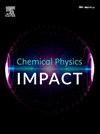铂纳米团簇结合在氧化锌纳米片上,具有增强的质量活性,可以有效地生产氢
IF 4.3
Q2 CHEMISTRY, PHYSICAL
引用次数: 0
摘要
采用水热法和化学还原法两步法将铂纳米团簇集成到氧化锌纳米片上。纳米团簇(Pt)和ZnO NSs之间的强烈相互作用提高了电子转移速率,从而产生了优异的HER电催化活性和优异的耐久性。在酸性介质(0.5 M)中,开发的Pt/ZnO NSs电催化剂相对于RHE实现了-44 mV的过电位,提供了-10 mA cm - 2的电流密度,低Tafel斜率为25 mV dec -1。Pt/ZnO NSs电极在-44 mV过电位下表现出较高的质量活性(194.3 mA mg−1),比20% Pt/C (57.14 mA mg−1)高3.4倍。Pt/ZnO电极的翻转频率(0.52 s−1)高于20% Pt/C电极的翻转频率(0.166 s−1)。阻抗谱测量研究了铂纳米团簇与ZnO纳米ss之间的强耦合相互作用,支持了高HER活性并促进了电子转移动力学。此外,Pt/ZnO纳米ss的电荷转移电阻小于20% Pt/C纳米ss的电荷转移电阻,这可能是由于ZnO和Pt之间的强相互作用以及电子从ZnO到Pt金属的易迁移性本文章由计算机程序翻译,如有差异,请以英文原文为准。

Platinum nanoclusters incorporated on zinc oxide nanosheets with enhanced mass activity for efficient hydrogen production
A two-step process using hydrothermal and chemical reduction methods was employed to integrate platinum nanoclusters onto zinc oxide nanosheets (ZnO NSs). The intense interaction between the nanoclusters (Pt) and ZnO NSs enhanced the electron transfer rate, resulting in exceptional electrocatalytic activity toward the HER and outstanding durability. In an acidic medium (0.5 M), the developed Pt/ZnO NSs electrocatalyst achieved an overpotential of -44 mV vs. RHE, affording a current density of -10 mA cm−2 with a low Tafel slope of 25 mV dec−1. The Pt/ZnO NSs electrode showed high mass activity (194.3 mA mg−1), 3.4-fold higher than the 20 % Pt/C (57.14 mA mg−1) at an overpotential of -44 mV. The turnover frequency of the Pt/ZnO NSs (0.52 s−1) is higher than that of the 20 % Pt/C (0.166 s−1) electrode. The impedance spectroscopy measurements investigated the strong coupling interaction between the platinum nanoclusters and ZnO NSs, which supports the high HER activity and facilitates electron transfer kinetics. Furthermore, the charge transfer resistance of the Pt/ZnO NSs is less than that of the 20 % Pt/C, which might be ascribed to the strong interaction between ZnO and Pt and the facile electron mobility from the conduction band of ZnO to Pt metal
求助全文
通过发布文献求助,成功后即可免费获取论文全文。
去求助
来源期刊

Chemical Physics Impact
Materials Science-Materials Science (miscellaneous)
CiteScore
2.60
自引率
0.00%
发文量
65
审稿时长
46 days
 求助内容:
求助内容: 应助结果提醒方式:
应助结果提醒方式:


